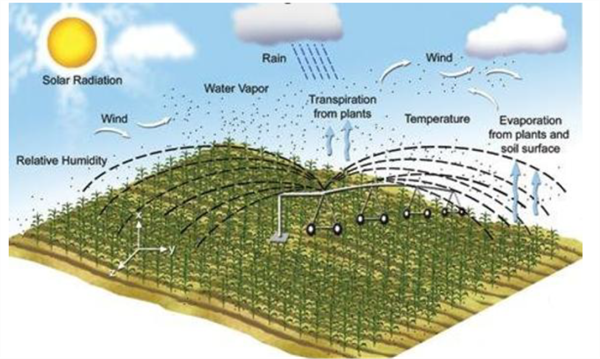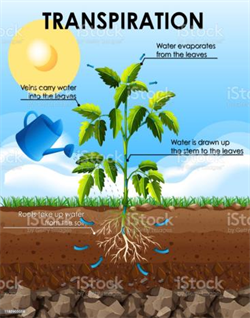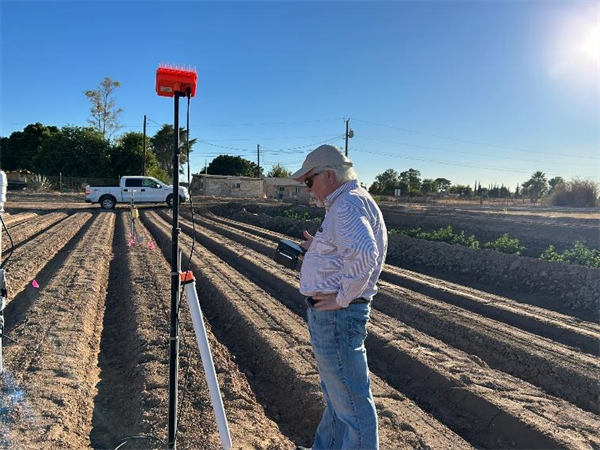
In the last issue of this UA Vegetable IPM Newsletter, I presented a melon (Cucumis melo ‘reticulatus’ L.) crop phenology model (Figure1; Silvertooth, 2025). This model can be useful in predicting and tracking crop development and identifying important stages of crop growth and development (crop phenology).
Use of a crop phenology model can be applied to basic crop management (e.g. fertilization, irrigation, harvest scheduling, pest management activities, labor, and machinery management, etc.). For use of the crop phenology model, good local weather data with heat unit information is needed. In Arizona we have an excellent weather system with the Arizona Meteorological Network, AZMET.
Since cantaloupes are a warm season crop, we use the86/55 ºF heat unit (HU) thresholds for phenological tracking. Key stages of growth or “guideposts” indicated in Figure 1represent the average or “target” values that are subject to a slight degree of natural variation, which is normal.
This melon crop phenology model was developed under fully irrigated and well-managed conditions. That is important since non-irrigated fields are more likely to experience water stress, which significantly disrupts crop development patterns.
Referring to the data from AZMET for several locations in the Yuma area, the HU accumulations (86/55 ºF thresholds) from 1 January 2025 to a set of four possible 2025 planting dates are listed in Table 1. The HU accumulations from 1 January2025 to 15 April 2025 for these sites are listed in Table 2.
The HU accumulations after planting (HUAP) for these four possible planting dates for three Yuma area locations to 15 April 2025 are shown in Table 3. The HUAP values in Table 3 are simply the difference between the values in Tables 1 and 2. An example for the Yuma Valley, 15 January 2025planting date is: HU - 73.1 HU = 645.6 ~ 646 HUAP.
The information in Table 3 can help serve as a reference to check for melon crop development in the field against this phenological model in Figure 2. Several cantaloupe/melon types are being in this region including western shipper type melons, Tuscan melons, and Hami melons. In the past, each of these melon types have tracked closely with this phenological model.
For melon crops in the lower Colorado River Valley at this time, we can expect to find fields planted and watered up in mid-January to have crown set melons beginning to develop netting, which may not be as apparent on the Hami melons. These fields could have crown fruit ready for harvesting in about three weeks, based on normal HU accumulation patterns for this time of year. For fields planted and wet dates near the first of March, these fields should be vigorously flowering.
Reference:
Silvertooth, J.C. 2025. Tracking Cantaloupe (Melon) Crop Growth and Development. University of
Arizona Vegetable IPM Newsletter, Volume 16, No.7, 2 April 2025.

Table 1. Heat unit accumulations (86/55 ºF thresholds) after 1 January 2025 on four possible 2025 planting dates utilizing Arizona Meteorological Network (AZMET) data for each representative site.
Yuma Valley: https://azmet.arizona.edu/application-areas/heat-units/station-level-summaries/az02
Yuma North Gila: https://azmet.arizona.edu/application-areas/heat-units/station-level-summaries/az14
Roll: https://azmet.arizona.edu/application-areas/heat-units/station-level-summaries/az24

Table 2. Heat unit accumulations (86/55 ºF thresholds) after 1 January 2025 to 14 April
2025 utilizing Arizona Meteorological Network (AZMET) data for each representative site.

Table 3. Heat unit accumulations (86/55 ºF thresholds) after planting (HUAP) from four
possible 2025 planting dates and three sites in the Yuma area on 15 April 2025 utilizing
Arizona Meteorological Network (AZMET) data for each representative site. Each value
is rounded to the next whole number. Note: the values in Table 3 are determined by
taking the difference between the HUs foreach representative site and four planting
dates in Tables 1 and 2.

Figure 1. Melon (cantaloupe) phenological development model expressed in Heat Units
Accumulated After Planting (HUAP, 86/55°F).
This study was conducted at the Yuma Valley Agricultural Center. The soil was a silty clay loam (7-56-37 sand-silt-clay, pH 7.2, O.M. 0.7%). Spinach ‘Meerkat’ was seeded, then sprinkler-irrigated to germinate seed Jan 13, 2025 on beds with 84 in. between bed centers and containing 30 lines of seed per bed. All irrigation water was supplied by sprinkler irrigation. Treatments were replicated four times in a randomized complete block design. Replicate plots consisted of 15 ft lengths of bed separated by 3 ft lengths of nontreated bed. Treatments were applied with a CO2 backpack sprayer that delivered 50 gal/acre at 40 psi to flat-fan nozzles.

Downy mildew (caused by Peronospora farinosa f. sp. spinaciae)was first observed in plots on Mar 5 and final reading was taken on March 6 and March 7, 2025. Spray date for each treatments are listed in excel file with the results.
Disease severity was recorded by determining the percentage of infected leaves present within three 1-ft2areas within each of the four replicate plots per treatment. The number of spinach leaves in a 1-ft2area of bed was approximately 144. The percentage were then changed to 1-10scale, with 1 being 10% infection and 10 being 100% infection.
The data (found in the accompanying Excel file) illustrate the degree of disease reduction obtained by applications of the various tested fungicides. Products that provided most effective control against the disease include Orondis ultra, Zampro, Stargus, Cevya, Eject .Please see table for other treatments with significant disease suppression/control. No phytotoxicity was observed in any of the treatments in this trial.
Interested in the latest developments in automated weeding machines and ag tech? There are a couple of opportunities at the upcoming 2025Southwest Ag Summit to stay up to date. One is the “Ag Tech: Innovations in Weed Control and Vegetable Crop Production Technologies” breakout session where university experts and cutting-edge innovators will provide updates on the latest advances in AI high precision smart spot sprayers and soil steaming for pest control (agenda below). The session will be held Thursday, February 20th from 1:30-3:30 pm at Arizona Western College (AWC) in Yuma, AZ.
The other is the Southwest Ag Summit Field Demo on Wednesday, February19th, where several of these technologies and other state-of-the-art automated weeders will be demonstrated operating in the field. The Field Demos will also be held at AWC. Breakfast will be served at 7:00 am and demonstrations begin at 8:00 am.
For more information about the Southwest Ag Summit, visit https://yumafreshveg.com/southwest-ag-summit/.
There are more than 50 broadleaf and grass weeds in this area that are common and have been here for a long time. It would be great to have an herbicide that will control all of them, be safe to the crop and be gone the next day after harvest.
Obviously, we are a long way from achieving this. What we have done instead is select for the weeds that escape our weed control practices. Anything that shifts the advantage to the crop instead of the weeds will help. Our practices include the use of herbicides, mechanical techniques and hand hoeing. Good weed control can be achieved using all three but may not be economical.
Weed selection due to herbicide availability was evident a few years ago when leaf lettuce was removed from the Kerb label in 2009. It is well known that Kerb, Prefar and Balan were the standard herbicides used in lettuce for the last 60years. Kerb will control the grasses and most of the broadleaves consistently including many that are not controlled by the other two products such as shepherds purse, london rocket and wild mustard. The longer that Kerb was unavailable the more prevalent some weeds would become. On January 12, 2016, the EPA label for Kerb was reinstated for leaf lettuce bringing back the tool to the industry1.
Prefar will control grass consistently, purslane and pigweed most of the time, lambs quarters and goosefoot some of the time. Balan will control grass consistently and many of the small-seeded broadleaves some of the time.
The postemergence grass herbicides were registered about 30 years ago but for broadleaf weeds there has not been a new registration in half a century.

Reference:
1. Retrieved from the www on Oct 14, 2024 https://ucanr.edu/blogs/blogcore/postdetail.cfm?postnum=21270#:~:text=On%20January%2012%2C%202016%20the%20Federal%20EPA,55%20day%20prior%20to%20harvest%20(Table%201).
2. https://cales.arizona.edu/crop/vegetables/advisories/more/weed122.html
As the weather gets cooler, aphids are migrating back to the desert to harm our crops. It is important to revisit some factors that may favor aphid infestations in your crops, specifically lettuce, and take appropriate action against them.
Nitrogen availability is one of the most important factors in the development of insect pest populations. Excessive application of nitrogen fertilizer to crops will likely increase the feeding preference and consumption rate of insect pests such as aphids, resulting in greater survival, growth, and reproduction. In some situations, high nitrogen levels in plant tissue can decrease resistance and increase susceptibility to aphids’ attacks.
Water management is also very important to consider. Excess water around plant roots can increase nitrogen uptake, which may favor an increase in the aphid population. Thus, supplying proper amounts of nitrogen and water to your crops can tremendously help with aphid management. See this link for more information on this topic.The combination of two separate processes whereby water is lost on the one hand from the soil surface by evaporation and on the other hand from the crop by transpiration, is referred to as evapotranspiration (ET). Evaporation is the process whereby liquid water is converted to water vapor (vaporization) and removed from the evaporating surface (vapor removal). Water evaporates from a variety of surfaces, such as lakes, rivers, pavements, soils, and wet vegetation. Energy is required to change the state of the molecules of water from liquid to vapor. Direct solar radiation and, to a lesser extent, the ambient temperature of the air provide this energy (Fig:1).

Figure 1: Key factors driving ET in agriculture include solar radiation, temperature, wind,
humidity, and plant and soil water loss.
Transpiration consists of the vaporization of liquid water contained in plant tissues and the vapor removal to the atmosphere. Crops predominantly lose their water through stomata. These are small openings on the plant leaf through which gases and water vapor pass. The water, together with some nutrients, is taken up by the roots and transported through the plant (Fig: 2).

Figure 2: A diagram illustrates the process of transpiration in plants, where water is
absorbed by roots, moves through the stem, and evaporates from the leaf surfaces.
Why evapotranspiration (ET)?
ET is the largest component of the hydrological cycle and is one of the most critical variables in irrigation management, crop production, and the sustainability of agriculture. It has a direct impact on water resources availability and use, water quality, and the earth’s energy balance. Daily evapotranspiration (ET) rates are needed for irrigation scheduling. The evapotranspiration rate is normally expressed in millimeters (mm) or inches (in) per unit of time (e.g., an hour, day, week, month, or even an entire growing period or year).
Reducing evapotranspiration (ET) can lead to significant water savings by minimizing unnecessary water loss through soil evaporation and plant transpiration. By applying irrigation more efficiently only when and where it's needed, plants can maintain optimal moisture levels, reducing stress and promoting better growth. This can enhance nutrient uptake, improve plant health, and ultimately lead to higher yields. Moreover, conserving water through reduced ET is especially critical in arid regions, where freshwater resources are limited, and efficient water use is essential for sustainable agricultural production.
Below are strategies to reduce ET

Figure 3: Figure 3. Soil moisture sensor installation at the Valley Research Center,
Yuma, AZ.
Results of pheromone and sticky trap catches can be viewed here.
Corn earworm: CEW moth counts down in all traps over the last month; about average for December.
Beet armyworm: Moth trap counts decreased in all areas in the last 2 weeks but appear to remain active in some areas, and average for this time of the year.
Cabbage looper: Moths increased in the past 2 weeks, and average for this time of the season.
Diamondback moth: Adults increased in several locations last, particularly in the Yuma Valley most traps. Below average for December.
Whitefly: Adult movement remains low in all areas, consistent with previous years
Thrips: Thrips adult movement continues to decline, overall activity below average for December.
Aphids: Winged aphids still actively moving but declined movement in the last 2 weeks. About average for December.
Leafminers: Adult activity down in most locations, below average for this time of season.